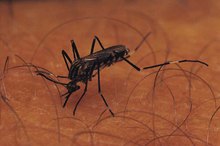Diseases That Raccoons Can Spread to Humans
Raccons are rather aggressive animals that can transfer diseases to people via bites, scratches and even indirect contact. Because it is not uncommon for us to sometimes encounter these furry animals around our homes, especially at night as they scavenge for food, it is important to take care while in their presence and use common precautions when handling materials they’ve contacted or left behind.
If you are experiencing serious medical symptoms, seek emergency treatment immediately.
Rabies Virus
The most common disease people acquire from raccoons is rabies 1. The rabies virus infects the central nervous system in humans, and it can lead to fevers, hallucinations and seizures. If a raccoon carries rabies, the virus is present in its saliva, so infected raccoons can transfer the disease via bites or scratches, as their claws are likely to have come in contact with their mouths. Staying away from raccoons in the wild is always a good idea, but this is especially true if their behavior appears especially aggressive or erratic. Rabies can be deadly, but there are very few confirmed cases of raccoon-acquired rabies that have resulted in human death.
- The most common disease people acquire from raccoons is rabies 1.
- If a raccoon carries rabies, the virus is present in its saliva, so infected raccoons can transfer the disease via bites or scratches, as their claws are likely to have come in contact with their mouths.
Salmonella
What Are the Dangers of Spitting?
Learn More
Salmonella bacteria are found in raccoon feces, and humans can contract Salmonella infections as the result of contacting droppings and subsequently ingesting the microorganisms by inadvertently transferring it from the hands to the mouth. These particular bacteria can lay dormant in a dry environment for an extended period of time, and can then become active under favorable conditions. Salmonella poisoning can lead to fever, abdominal pain and severe diarrhea. It can be particularly dangerous to children, the elderly and immunocompromised individuals.
- Salmonella bacteria are found in raccoon feces, and humans can contract Salmonella infections as the result of contacting droppings and subsequently ingesting the microorganisms by inadvertently transferring it from the hands to the mouth.
- It can be particularly dangerous to children, the elderly and immunocompromised individuals.
Roundworm
Raccoons can excrete high numbers of roundworm eggs through their feces. The eggs are light and can become airborne, potentially leading to infections resulting from inhalation. Incidental ingestion can also infect a host. Roundworm parasites can lead to serious health issues in humans as they affect the central nervous system, and can impair the body’s organs, including the brain. The most severe roundworm-related infections can result in vision loss or even comas.
- Raccoons can excrete high numbers of roundworm eggs through their feces.
- Roundworm parasites can lead to serious health issues in humans as they affect the central nervous system, and can impair the body’s organs, including the brain.
Leptospirosis
Skin Rashes Caused by Cats
Learn More
The bacterium Leptospira causes the disease Leptospirosis, which infects humans and a host of other animals, including raccoons. They excrete this particular microorganism through their urine; as such, people can become infected by drinking water that has been contaminated with these bacteria. Mild cases of Leptospirosis can result in high fevers, body pain and both vomiting and diarrhea. More serious cases may lead to anemia, meningitis and liver failure.
- The bacterium Leptospira causes the disease Leptospirosis, which infects humans and a host of other animals, including raccoons.
- Mild cases of Leptospirosis can result in high fevers, body pain and both vomiting and diarrhea.
Related Articles
References
- King County Health Services: Diseases from Raccoons
- Raccoon Attic Guide: Raccoon Diseases
- Centers for Disease Control and Prevention. Human Rabies. Updated June 11, 2019.
- Pieracci EG, Pearson CM, Wallace RM, et al. Vital Signs: Trends in Human Rabies Deaths and Exposures - United States, 1938-2018. MMWR Morb Mortal Wkly Rep. 2019;68(23):524-528. doi:10.15585/mmwr.mm6823e1
- Ma X, Monroe BP, Cleaton JM, et al. Rabies surveillance in the United States during 2016. J Am Vet Med Assoc. 2018;252(8):945-957. doi:10.2460/javma.252.8.945
- Igreja RP. Infectious Diseases Associated with Caves. Wilderness Environ Med. 2011;22(2):115-121. doi:10.1016/j.wem.2011.02.012
- World Health Organization. Rabies. 2019.
- Zhang J, Lin J, Tian Y, et al. Transmission of rabies through solid organ transplantation: a notable problem in China. BMC Infect Dis. 2018;18(1):273. doi:10.1186/s12879-018-3112-y
- Rupprecht C, Kuzmin I, Meslin F. “Lyssaviruses and rabies: current conundrums, concerns, contradictions and controversies.” F1000Res. 2017 Feb 23;6:184.
- The Humane Society of the United States. “How to Avoid a Dog Bite.” Last accessed April 2018.
Writer Bio
Demi Buckley's 10 years of professional writing experience have included investigational and technical writing positions for some of the biggest names in the pharmaceutical industry, including Abbott Laboratories and Baxter Health Care. He earned his B.S. in biology (with a minor in English/creative writing) from Northeastern Illinois University in Chicago.









